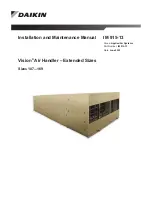
74
CLCH-SVX009J-EN
Troubleshooting
This section is intended to be used as a diagnostic aid only.
For detailed repair procedures, contact your local Trane
service representative.
WARNING
Hazardous Service Procedures!
Failure to follow all of the recommended safety warnings provided could result in death or serious injury. The
maintenance and troubleshooting procedures recommended in this manual could result in exposure to electrical,
mechanical or other potential safety hazards. Always refer to the safety warnings provided throughout this manual
concerning these procedures. Unless specified otherwise, disconnect all electrical power including remote disconnect
and discharge all energy storing devices such as capacitors before servicing. Follow proper lockout/tagout procedures
to ensure the power can not be inadvertently energized. When necessary to work with live electrical components,
have a qualified licensed electrician or other individual who has been trained in handling live electrical components
perform these tasks.
Table 22. Air handler troubleshooting recommendations
Symptom
Probable Cause
Recommended Action
Bearing is
excessively hot
First start after relubrication (Grease distribution)
Allow machine to cool down and restart.
Over-lubrication
Clean surface of grease and purge.
Over tensioned belts
Adjust belt tension.
No lubricant
Apply lubricant. Check bearings for damage.
Misaligned bearing
Correct alignment. Check shaft level.
Motor fails to
start
Blown fuse or open circuit breaker
Replace fuse or reset circuit breaker.
Overload trip
Check and reset overload.
Improper wiring or connections
Check wiring with diagram supplied on unit.
Improper current supply
Compare actual supply power with motor nameplate recommendations.
Contact power company for adjustments.
Mechanical failure
Check that motor and drive rotate freely. Check bearing lubricant.
Motor stalls
Open phase
Check line for an open phase.
Overloaded motor
Reduce load or replace with larger motor.
Low line voltage
Check across AC line. Correct voltage if possible.
Excessive
vibration
Poor alignment
Align bearing set screws (see
). Loosen and retighten
bearing set screws.
Over tensioned belts
Adjust belt tension.
Misaligned drive
Align drive.
Motor runs and
then dies down
Partial loss of line voltage
Check for loose connections. Determine adequacy of main power supply.
Starter shorts when motor warms up
Replace starter.
Motor does not
come up to
speed
Low voltage at motor terminals
Check across AC line and correct voltage loss if possible.
Line wiring to motor too small
Replace with larger sized wiring.
Motor overheats
Overloaded motor
Reduce load or replace with a larger motor.
Motor fan is clogged with dirt preventing proper
ventilation
Remove fan cover, clean fan and replace cover.
Excessive motor
noise
Motor mounting bolts loose
Tighten motor mounting bolts.
Rigid coupling connections
Replace with flexible connections.
Worn motor bearings
Replace bearings and seals.
Fan rubbing on fan cover
Remove interference in motor fan housing.
Rapid motor
bearing wear
Excessive overhung load due to over tensioned drive Check belt tension and overhung load.
Excessive overhung load due to a small diameter motor
sheave
Replace sheave with larger one.
Loose fan belt
Motor is poorly positioned
Adjust belt tension.
Worn or damaged belt
Replace belt or belt set. Check sheave alignment.
Worn sheaves
Replace sheaves.
Short belt life
Worn sheaves
Replace sheaves.
Misaligned belt
Realign drive with MVP sheave set at mean pitch diameter.
Grease or oil on belts
Check for leaky bearings. Clean belts and sheaves.
Belt slipping
Improper belt tension. Adjust tension.
Belts rubbing
Remove obstruction or realign drive for clearance.



























